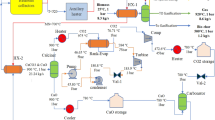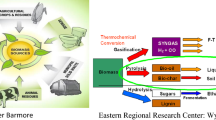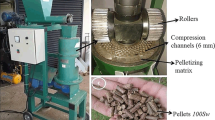Abstract
Solar energy is an ecofriendly potential alternative to nonrenewable sources of energy, which are becoming increasingly scarce. Issues with the use of solar energy, such as temporal variations in the intensity of sunlight, could be solved by storing solar energy. This work introduces the concept of using waste as a sustainable material for energy storage. Sugarcane crop is a potential feedstock for the agro-industry in Egypt. However, while sugarcane is a source of both ethanol and sugar, extracting these substances from sugarcane results in a significant amount of solid biomass waste, known as “bagasse”. This investigation demonstrates that sugarcane bagasse, which is produced in increasingly large quantities each year, could be employed in a cost-efficient method of storing solar energy. In this study, the bagasse was modified using facile chemical and thermal treatments and then examined using XRD (X-ray diffractometry) and SEM (scanning electron microscopy), which revealed the presence of quartz. An inexpensive solar energy storage material was then created by impregnating paraffin wax with the treated bagasse using an ultrasonic technique. This composite material showed excellent form-stable phase-change behaviour that allowed it to absorb large amounts of solar energy, especially around solar noon, and store that energy in the form of heat. The composite was found to store 72 kJ/min of heat, as compared to only 7 kJ/min for pure paraffin. Thus, this study suggests that a composite material capable of enhanced solar energy storage can be created from industrial waste, permitting an environmentally integrated approach to storing green energy.








Similar content being viewed by others
Abbreviations
- PCM:
-
Phase-change material
- BG:
-
Bagasse
- PCM/BG:
-
Phase-change material/bagasse
- PCM/BG500:
-
Phase-change material/bagasse treated at 500 °C
- TES:
-
Thermal energy storage
- HTF:
-
Heat transfer fluid
- m :
-
Mass flow rate of water
- C p :
-
Specific heat of water
- Q :
-
Heat stored
References
Abo-State M, Ragab A, EL-Gendy N, Farahat L, Madian H (2013) Effect of different pretreatments on Egyptian sugar-cane bagasse saccharification and bioethanol production. Egypt J Petr 22:161–167
Ashour EA, Tony MA (2017) Equilibrium and kinetic studies on biosorption of iron (II) and iron (III) ions onto eggshell powder from aqueous solution. Appl Eng 1(3):32–40
Ashour A, Tony MA, Purcell PJ (2014) Use of agriculture-based waste for basic dye sorption from aqueous solution: kinetics and isotherm studies. Am J Chem Eng 2(6):92–98
Chaichan MT, Kamel SH, Al-Ajeely AN (2015) Thermal conductivity enhancement by using nano-material in phase change material for latent heat thermal energy storage systems. Saussure 5(6):48–55
Chieruzzi M, Miliozzi A, Crescenzi T, Torre L, Kenny JM (2015) A new phase change material based on potassium nitrate with silica and alumina nanoparticles for thermal energy storage. Nanosc Res Lett 10:273–283
Council of Sugar Crops (2008) Sugar crops and sugar production in Egypt. Ministry of Agriculture and Land Reclamation, Cairo, p 28
Doherty L, Zhao YQ, Zhao XH, Wang W (2015) Nutrient and organics removal from swine slurry with simultaneous electricity generation in an alum sludge-based constructed wetland incorporating microbial fuel cell technology. Chem Eng J 266(15):74–81
Dwivedi VK, Tiwari P, Tiwari S (2016) Importance of phase change material (PCM) in solar thermal applications: a review. In: Int Conf on Emerging Trends in Electrical, Electronics and Sustainable Energy Systems (ICETEESES-16), Sultanpur, India, 11–12 Mar 2016
Fang Y, Wei H, Liang X, Wang S, Liu X, Gao X, Zhang Z (2016) Preparation and thermal performance of silica/n-tetradecane microencapsulated phase change material for cold energy storage. Energy Fuels 30:9652–9657
Farahat MA, Mousa MM, Mahmoud NH (2016) Solar distiller with flat plate collector and thermal storage. In: 17th Int Conf on Applied Mechanics and Mechanical Engineering, Military Technical College, Cairo, Egypt, 19–21 Apr 2016, pp 19–21
Farid MM, Khudhair AM, Razack SK, Al-Hallaj S (2004) A review on phase change energy storage: materials and applications. Energy Convers Manag 45:1597–1615
Harikrishnan S, Deenadhayalan M, Kalaiselvam S (2014) Experimental investigation of solidification and melting characteristics of composite PCMs for building heating application. Energy Convers Manag 86:864–872
Hassan S, Nas M (2008) Sugar industry in Egypt. Sugar Tech 10(3):204–209
Ho CJ, Gao JY (2009) Preparation and thermophysical properties of nanoparticle-in-paraffin emulsion as phase change material. Inter Commun Heat Mass Transfer 36:467–470
Jia L, Chen Y, Mo S (2013) Solid–liquid phase transition of nanofluids. Int J Heat Mass Trans 59:29–34
Karthikeyan M, Ramachandran T, Shanmugasundaram OL (2014) Synthesis, characterization, and development of thermally enhanced cotton fabric using nanoencapsulated phase change materials containing paraffin wax. J Text Inst 105(12):1279–1286
Kaviarasu C, Prakash D (2016) Review on phase change materials with nanoparticle in engineering applications. J Eng Sci Technol Rev 9(4):26–386
Kaygusuz K, Sari A (2005) Thermal energy storage system using a technical grade paraffin wax as latent heat energy storage material. Energy Sour 27(16):1535–1546
Lane GA (1980) Low temperature heat storage with phase change materials. Int J Energy Res 5:155–160
Mohamed EF, El-Hashemy MA, Abdel-Latif NM, Shetaya WH (2015) Production of sugarcane bagasse-based activated carbon for formaldehyde gas removal from potted plants exposure chamber. J Air Waste Manag Assoc 65(12):1413–1420
Muller K, Bugnicourt E, Latorre M, Jorda M, Sanz YE, Lagaron JM, Miesbauer O, Bianchin A, Hankin S, Bolz U, Perez G, Jesdinszki M, Lindner M, Scheuerer Z, Castello S, Schmid M (2017) Review on the processing and properties of polymer nanocomposites and nanocoatings and their applications in the packaging, automotive and solar energy fields. Nanomaterials 7(4):74
Ola O, Chen Y, Zhu Y (2019) Three-dimensional carbon foam nanocomposites for thermal energy storage. Solar Energy Mater Sol Cells 91:297–305
Pakrouh R, Hosseini MJ, Ranjbar AA, Bahrampoury R (2015) A numerical method for PCM-based pin fin heat sinks optimization. Energy Convers Manag 103:542–552
Peng P, Huang G, Wang P, Li W, Chang W, Ma J, Li C (2019) Effects of thermal conductivity and density on phase change materials-based thermal energy storage systems. Energy 172:580–591
Peng G, Dou G, Hu Y, Sun Y, Chen Z (2020) Phase change material (PCM) microcapsules for thermal energy storage. Adv Polym Technol. https://doi.org/10.1155/2020/9490873
Sanusi O, Warzoha R, Fleischer AS (2011) Energy storage and solidification of paraffin phase change material embedded with graphite nanofibers. Int J Heat Mass Transf 54(19):4429–4436
Shchukina EM, Graham M, Zheng Z, Shchukin D (2018) Nanoencapsulation of phase change materials for advanced thermal energy storage systems. Chem Soc Rev 47:4156–4157
Skovajsa J, Kolacek M, Zalesak M (2017) Phase change material based accumulation panels in combination with renewable energy sources and thermoelectric cooling. Energies 10(2):152. https://doi.org/10.3390/en10020152
Sun N, Wen X, Yan C (2018) Adsorption of mercury ions from wastewater aqueous solution by amide functionalized cellulose from sugarcane bagasse. Int J Biol Macromol 108:1199–1206
Tony MA (2019a) An industrial ecology approach: green cellulose based bio-adsorbent from sugar industry residue for treating textile industry wastewater effluent. Int J Environ Anal Chem. https://doi.org/10.1080/03067319.2019.1661397
Tony MA (2019b) “Sun in a box” day-to-night solar energy storage for heating and cooling applications utilizing zeolite synthesized from waste residues towards energy density enhancement. In: 5th Int Conf on Energy Engineering, Aswan, Egypt, 24–26 Dec 2019
Tony MA (2020a) Central composite design optimization of Bismarck Dye oxidation from textile effluent with Fenton’s reagent. Appl Water Sci 10(5):108
Tony MA (2020b) Zeolite-based adsorbent from alum sludge residue for textile wastewater treatment. Int J Environ Sci Technol 17:2485–2498. https://doi.org/10.1007/s13762-020-02
Tony MA, Lin LS (2020) Iron recovery form acid mine drain sludge as a Fenton source for municipal wastewater treatment. Int J Environ Anal Chem. https://doi.org/10.1080/03067319.2020.1734196
Tony MA, Mansour SA (2020) Sunlight-driven organic phase change material-embedded nanofiller for latent heat solar energy storage. Int J Environ Sci Technol 17(2):709–720
Tony MA, Tayeb A (2011) The use of solar energy in a low-cost drying system for solid waste management: concept, design and performance analysis. In: Eurasia Waste Management Symp, Istanbul, Turkey, 14–16 Nov 2011
Tony MA, Tayeb A (2016) Response surface regression model in optimization of alum sludge drying facility: solar-Fenton’s reagent dewatering. Int J Chem Eng Appl 7(5):331–335
Tony MA, Tayeb A, Zhao YQ (2016) An alternative arrangement for the alum sludge management: minimising waste with low-cost solar techniques. Am J Chem Eng 4(2):30–37
Tony MA, Tayeb A, Masnour SA (2017) State-of-the-art ultrasonic dispersion of nanoparticles into phase change material (PCM) for solar storage media—nano-oxide-PCM or conventional PCM? In: 4th Int Conf on Energy and Engineering (ICEE-4), Aswan, Egypt, 26–28 Dec 2017
Tony MA, Parker H, Clark J (2018) Evaluating Algibon adsorbent and adsorption kinetics for launderette water treatment: towards sustainable water management. Water Environ J 33:401–408. https://doi.org/10.1111/wej.12412
Umesh K, Dhiraj S (2005) Optimization of process parameters for removal of Cr(VI) from aqueous solutions using modified sugarcane bagasse. Electr J Environ Agric Food Chem 6:1150–1160
Wang J, Xie H, Xin Z, Li Y, Chen L (2009) Thermal properties of paraffin based composites containing multi-walled carbon nanotubes. Thermochim Acta 488:39–44
Wang X, Chen Z, Xu W, Wang X (2019) Capric acid phase change microcapsules modified with graphene oxide for energy storage. J Mater Sci 54(24):14834–14844
Wu S, Wang H, Xiao S, Zhu D (2012) Numerical simulation on thermal energy storage behavior of Cu/paraffin nanofluids PCMs. Proced Eng 31:240–244
Yu S, Jeong SG, Chung O, Kim S (2014) Bio-based PCM/carbon nanomaterials composites with enhanced thermal conductivity. Solar Energy Mater Sol Cells 120:549–554
Zhao YQ, Keogh C, Tony MA (2009) On the necessity of sludge conditioning with non-organic polymer: AOP approach. J Resid Sci Technol 6(3):151–155
Acknowledgements
The sugarcane milling facility in Minia City in southern Egypt is thanked for providing the milled sugarcane bagasse residues.
Author information
Authors and Affiliations
Corresponding author
Ethics declarations
Conflict of interest
The author confirms that there is no conflict of interest.
Additional information
Communicated by Jayanarayan Sahu, Chief Editor.
Rights and permissions
About this article
Cite this article
Tony, M.A. From biomass residue to solar thermal energy: the potential of bagasse as a heat storage material. Euro-Mediterr J Environ Integr 5, 17 (2020). https://doi.org/10.1007/s41207-020-00158-y
Received:
Accepted:
Published:
DOI: https://doi.org/10.1007/s41207-020-00158-y




